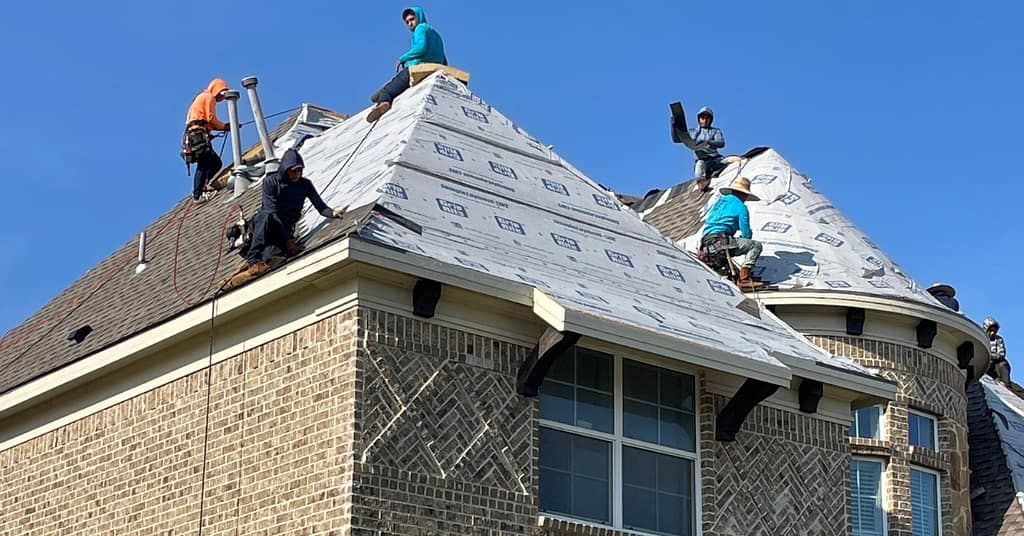
What’s the Best Roof in Texas for Weather Protection?
Whether it’s the scorching summer heat, high-impact hailstorms, or the heavy winds and rain that come with thunderstorms, Texas weather puts homes under a lot of stress. That’s why what your roof is made of is so important. Far beyond curb appeal, investing in the right roof for your home can protect your property for decades. In our comprehensive guide to roofing materials, we listed the pros and cons of the most common materials. In this guide, we’ll see how a few standouts are uniquely suited to bear tough Texas conditions to find the best roof in Texas.
UV Exposure & High Heat
Texas summers are some of the hottest in the country. It isn’t uncommon to endure streaks of 100-degree days, especially in the central and southern regions. That’s no small thing for your roof. Not only can the sheer heat cause damage like blistering, but the constant exposure to harsh ultraviolet rays causes its own kind of deterioration. Because roofs also play a big role in regulating the temperature of homes, their ability to reflect and insulate can help reduce cooling costs during summer months as well.
- Asphalt shingles: can suffer from UV degradation and heat exposure, leading to cracking, blistering, or general wear and tear. But higher-quality architectural shingles, particularly those with reflective coatings, can help reduce heat absorption and improve energy efficiency, making them a viable budget-friendly option.
- Metal roofs: Metal roofing is highly resistant to UV rays and extreme heat, and because it’s so reflective, it also keeps homes cooler. That means less heat-related damage and lower energy bills. High-quality metal roofs are also tough enough to withstand warping or fading in the Texas sun.
- Slate: is naturally resistant to heat and UV radiation, which is part of the reason slate roofs can last around 100 years. Like metal roofs, slate’s ability to reflect heat helps with energy efficiency, and its longevity means it won’t degrade under constant sun exposure. While more expensive, slate is an excellent long-term investment.
High-Impact Hailstorms
And who could forget the hail? Texas’ hailstorms can cause significant damage to roofs that aren’t graded to withstand them — and even high-grade materials may be punctured or cracked from hailstorms with considerable force. This brings us to our next important feature of a good roof: impact resistance.
- Asphalt shingles, particularly architectural and premium variants, offer good protection against hail. While standard asphalt shingles may crack or dent under larger hail, premium options can provide more durability. Still, the shorter lifespan, lower durability, and higher maintenance needs mean asphalt shingles are best for homeowners on a budget.
- Metal roofing is pricier, but it’s one of the most durable options available when it comes to impact resistance. Steel, aluminum, and other metal options can hold up to most hailstorms without denting or cracking. That’s why metal is a common choice for Texans in hail-prone areas.
- Slate is extremely resistant to hail due to its natural stone composition. It’s one of the most durable materials for withstanding hail impacts. While it’s also among the most expensive roofing materials, its extremely long lifespan and high durability make it a great investment.
Strong Winds
The Lone Star State isn’t a stranger to very strong winds either, from thunderstorms to tornadoes. The central and northern parts of the state see wind speeds exceeding 100 mph, so homeowners need to ensure their roofs remain intact and fastened during these powerful gusts. Otherwise, materials can lift, become detached, and cause even bigger problems as storms begin affecting exposed areas of your home.
- Asphalt shingles, particularly architectural and premium variants, are designed to withstand high winds. Lower-end 3-tab asphalt shingles, on the other hand, will be much more vulnerable to lifting in severe gusts, especially during tornadoes or strong thunderstorms.
- Metal roofs excel in high wind conditions, making them ideal for Texas areas prone to tornadoes and severe thunderstorms. They resist lifting and damage better than many other materials, often due to their interlocking panels and strong fasteners.
- Slate roofs are sturdy and heavy, which makes them very resistant to strong winds. Still, slate can crack or break if struck by flying debris or extremely high winds, but this premium material, alongside metal, is still in a league of its own compared to other roofing materials, like wood or asphalt.
Heavy Rain
Texas is also known for its rainstorms. To provide adequate protection, a roof needs to be able to shed water, prevent pooling, and protect from leaks. Otherwise, mold, rot, and structural damage can occur.
- Asphalt shingles shed water effectively, but without proper maintenance, they can wear down, leaving your roof vulnerable to water damage. Higher-quality asphalt variants can perform well in wet conditions, but in areas with consistent rainfall, frequent maintenance will be required.
- Metal roofs are excellent at shedding water. Their smooth surface ensures that rain runs off quickly, preventing pooling and leaks. Additionally, metal roofs are resistant to mold and mildew, making them a great option for wet climates where rain is frequent.
- Slate performs exceptionally well in heavy rain, capable of shedding water without absorbing moisture. Due to the strength and long lifespan of slate, and its natural resistance to mold and mildew, slate roofs can lock in decades, maybe even a century, of dependable protection.
We’re Here to Help
When it comes to balancing affordability, versatility, and durability, metal roofs may be the best roof in Texas. Need an expert opinion? Don’t hesitate to contact the DFW Roofer team with your questions about choosing the right roof. Call us at (469) 751-4018 or schedule an appointment through our online appointment form.

